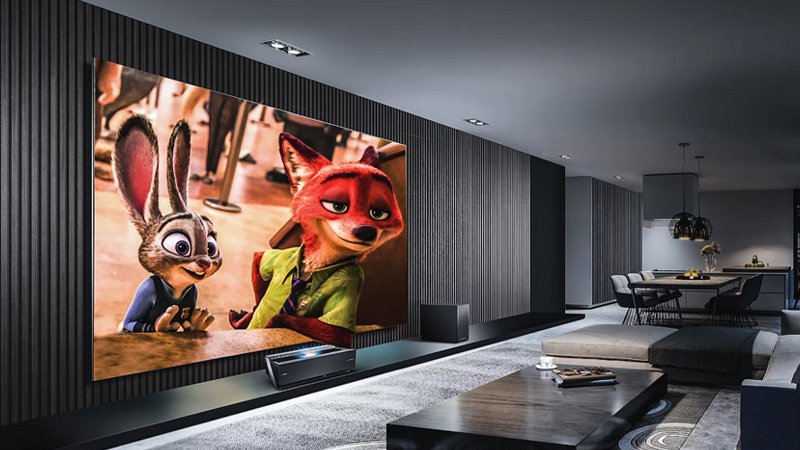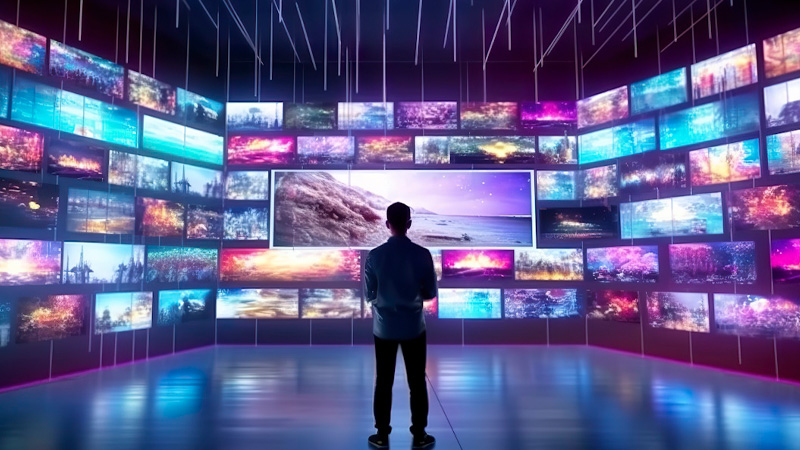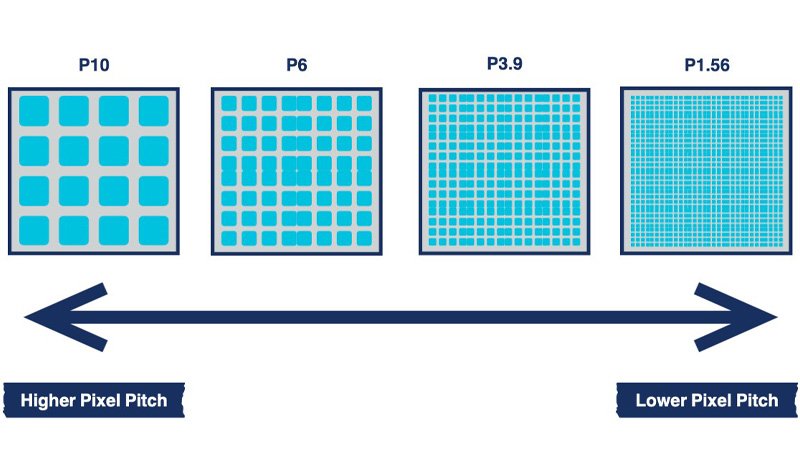When we talk about display resolution, we think of the clarity and precision of a particular display content in display technology. We think about pixels and their density, but did you know there are ways to measure pixel density?
Pixel pitch is one such way. This article explains pixel pitch, how it can impact resolution, and your choice of display technology.
1. What is Pixel Pitch?
If you see an image on a monitor, try to imagine the pixels in it. First, imagine a particular pixel having a center. Then imagine that there are pixels left and right, above and below, each with a center.
Now, imagine the distance between those centers. The distance, measured in millimeters, is what you call a pixel pitch. Also called a dot pitch, pixel pitch ultimately determines the resolution of a particular display content and, thus, its clarity, precision, color texture, etc. It has, therefore, an impact on the overall feel and appeal of the content.
But why is this so? That is because a pixel pitch is about the distance or how far pixels are from one another. Since a pixel is a basic unit in a display resolution, more considerable distances between pixels mean more significant gaps or empty spaces between those basic units.
More significant gaps mean lower resolution. On the other hand, smaller gaps mean less space between pixels, meaning the pixels are closer to one another. This indicates higher density, and the higher the pixel density, the higher the resolution.
We indicate the measurement of pixel pitch through the formula p(mm) – P for pixels and mm stands for millimeter, the measured distance. Depending on the distance, you indicate the pixel pitch. Pixels separated by 2 millimeters, will be P2, by 3, P3, and so on….
There is a correlation in the measurement of pixel pitch, and it directly impacts the resolution. The lowest possible measurement of pixel pitch is P1; a P2 means twice the distance of P1; hence, a P1 is twice as clear as a P2. If one is P5, it means P1 has a higher resolution, five times that of p5.
As we will see later, the pixel pitch and those measurements have a direct impact on display technologies and the viewing experience.
2. Why does Pixel Pitch Matter?
All things being equal, the lower the pixel pitch, the higher the resolution. As a rule, the higher the resolution, the greater the clarity and precision. However, two critical factors impact and affect the clarity of a given image in a display resolution: the size of the display technology, and the viewer’s distance.
The two factors can either negate the high-resolution imaging resulting from a lower pixel pitch or enhance the resolution of display content having a higher pixel pitch. They affect how we see things in any display technology.
A lower pixel pitch means tightly packed pixels, which is best for greater precision and finer details, resulting in the very high resolution craved by many viewers. However, you also need to be at a certain distance to optimize the lower pixel pitch given by the display technology.
Distance and the size of the display technology can negate the advantages of finer details. For those who want a more immersive viewing experience through lower pixel pitch, the appropriate display technology is needed. For example, you need the right television monitor with the right size to enjoy your favorite shows or games.
For this reason, experts adjust the pixel pitch depending on the size and particular use of the display technology. If only higher resolution had been the issue, all would have had the same pixel pitch.
Pixel pitch, therefore, is there specifically to optimize the viewer experience by having the best resolution possible. The best resolution is not the highest resolution but the one that can give you the best clarity for an enhanced, immersive experience, considering both the size, the use, and the distance of the display technology to the viewer.
3. The Size of Display Technology
Larger display technologies, like LED walls, are for large viewing audiences. As such, they offer immersive viewing experiences unlike those offered by home theaters and other indoor display technologies.
Their need for a lower resolution is not greater than that of smaller display technologies since attention to finer details is not essential. Since extensive, gigantic display technologies are primarily for advertisement purposes rather than games or personal entertainment, the need for a lower pixel pitch is not greater.
This is in direct contrast to home theaters, LED televisions, and all those display technologies used for entertainment, like watching and playing games. These require higher resolution (hence, lower pixel pitch) to maximize the viewing experience and optimize the aesthetics.
The sizes of entertainment display technologies are limited to maximize everything they offer and optimize the experience. That is not the case with LED walls. You can customize and increase their size depending on the purpose, location, audience, and distance to the viewer.
However, suppose you want your LED wall’s highest resolution possible. You can do that, but it will come at a cost. First, having LED panels with tightly packed pixels is more expensive. Second, because of the purpose, location, and distance, having tightly packed pixels may not give you any advantage.
Most LED walls are used for advertising purposes, so they mainly include text and the like. Unlike games and films, these display contents usually do not need further optimization for enhanced viewing pleasure. Viewers and audiences simply must read what is written, nothing more.
It will not make sense to employ lower pixel pitch for outdoor, very large display technologies such as LED walls precisely because it will not serve its purpose. Not only because they may not need it but also because of another factor: distance.

4. The Role of Distance
A lower pixel pitch can give you the highest resolution and, by implication, the best immersive experience possible, but only if the display technology is at a certain distance where you can maximize those effects.
Screens and monitors for entertainment are for close viewing. The relative distance can either enhance or negate the aesthetic experience. Given the circumstances, it is easy to adjust: all you have to do is move closer or move the screen.
This is in direct contrast to LED walls and other gigantic display technologies employed outdoors, especially for advertisement. They are gargantuan precisely because they are usually placed at a faraway distance, in specific locations. This allows everyone to see and experience the same thing without sacrificing much of its quality.
In fact, if you came close to a large LED wall, it would be apparent that it has a far lower resolution than most HD televisions. However, and ironically, distance negates what is apparent in close observation. Images, in fact, appear clearer and clearer.
The key to the paradox lies in the pixel pitch. Since higher pixel pitch means more significant gaps and empty spaces between pixels, the distance can paradoxically close that gap, making it appear that pixels are closer to one another.
It paradoxically enhances the image quality, giving greater clarity. Again, this is possible only because the minute details and greater precision, so crucial in entertainment displayed in most HD televisions, are not that important, at least in the case of most LED walls.

5. How Pixel Pitch Can Impact Your Choice of Display Technology
We contrast LED walls to smaller display technology only to highlight the fact that a lower pixel pitch does not guarantee you have the best resolution possible. It is also best to contrast them to emphasize the relationship between pixel pitch, size of display technology, and distance.
HD screens and monitors use a particular measurement, the PPI or pixels per inch. Here, the higher the PPI, the higher the pixel density. The reason for contrast should be apparent: we measure in PPI the number of pixels in each area, in pixel pitch, the distance.
The essential principles, though, remain the same. LED walls and the like use perfect pitch because the size of the screen and the distance affect the best resolution possible. Therefore, when assembling the screens for your ideal LED wall, it is important to bear in mind how large, how far, and the pixel pitch they contain.
Here is a rough guide for pixel pitch and how to optimize your display technology for viewing:
● The lower the pixel pitch, the closer the distance; the higher, the farther.
● Indoor display technologies viewed within 5 feet should be less than P5.
● Display technologies outdoors viewed from around 20 feet should have P5-P10.
● For those farther away, like those on top of buildings and other structures, display technologies should be at P10-P20.
Everything will eventually depend on the actual size of the display technology, its distance to the viewers, and other advanced technology available to enhance the quality and clarity.
We at LEDSINO can offer help and guidance on pixel pitch and choosing the right display technology. We ensure that you get the best bargain for the better viewing experience you can give your audience.

6. Final Thoughts
A higher resolution does not mean better for LED walls and the like. The size of the display technology and the distance from the viewer can significantly impact the viewing experience.
Pixel pitch is a measurement that will help you choose the best display technology. By calculating the pixel pitch, size, and distance, you can better gauge which display technology is appropriate and best.


